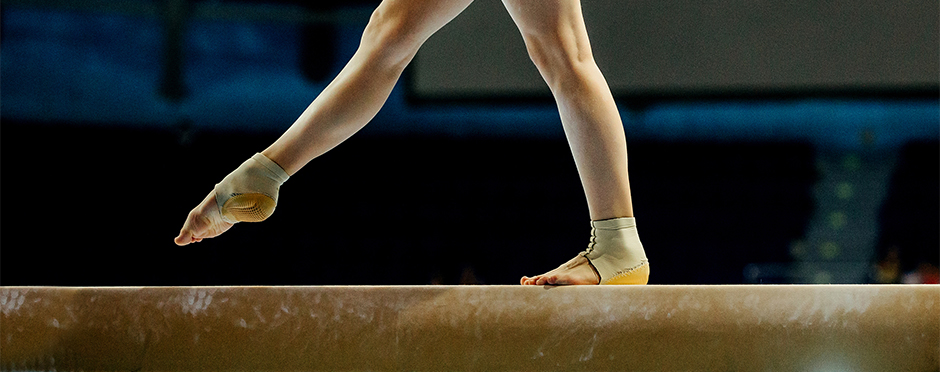
Sever’s Disease in Gymnasts
Leave a CommentMany young kids that participate in sports can have complaints of pain in their heels. This is more common in children who are actively growing and those who are very active in running and jumping sports. Young gymnasts fall into this category, and they also practice and compete barefoot, which can lead to a higher risk of injury to the foot.
What is Sever’s Disease?
Sever’s disease is inflammation of the growth plate on the back of the heel. It is also called calcaneal apophysitis. The Achilles tendon attaches near this growth plate on the heel. Bones often grow first, and our muscles have to stretch to accommodate this new bone length. This can lead to tightness in our muscles. If the Achilles tendon is tight, the repetitive pulling during jumping and running can lead to irritation of the growth plate in the heel. The Achilles tendon is comprised of the two muscles in our calf, the gastrocnemius, and the soleus muscles.
Causes of Sever’s Disease:
- Growth spurt
Sever’s disease may be aggravated by:
- Overtraining
- Running and jumping on hard surfaces (ex: track, basketball, gymnastics)
- Shoes that don’t support the feet well
Symptoms of Sever’s Disease:
- Pain in the heel, worse after running
- Possible limp
- Tenderness the over back of the heel with touch or weight onto heels
- Pain can extend to the bottom of the foot or side of foot
- Increased pain standing on 1 foot
- Foot stiffness after sleeping
- Rare instances, you can have mild swelling or redness around the heel
Treatment for Sever’s Disease:
Activity Modification: Rest is one of the first recommendations for children with Sever’s disease. Limiting the amount of running and jumping activities or even stopping an activity for a short period can be helpful to calm down the irritation to the heel. RICE (rest, ice, compression, and elevation) is also a common recommendation for treatment for the symptoms of Sever’s disease. As physical therapists, our goal is to return our patients to their desired activities as quickly as possible; sometimes, this means stopping all activities for a short period to jump-start the rehabilitation process.
Other modifications for gymnasts include using soft mats for landing and limiting the number of repetitions for running and jumping skills. Gymnasts should also be encouraged to wear supportive tennis shoes at school and home rather than being barefoot. A more supportive shoe can also protect the tender area over the heel during the gymnast’s daily tasks.
Wear a brace: Several braces can be helpful to manage the symptoms of sever’s disease including a heel cup, X-brace, or Tuli’s cheetah heel protector. These provide more cushioning over the heel area when the athlete is barefoot at practice or competition.
Stretches: Frequent calf stretching can help manage the pain from Sever’s disease. Gymnasts should focus on stretching both muscles in the calves, as mentioned above.
- Gastrocnemius stretching: Stand with both toes facing the wall, feet in a staggered position. Keep the back leg straight and heel on the ground, and bend the front knee until a stretch is felt in the calf of the back leg. Hold for 30 seconds, 2-3 repetitions, and perform on both legs.
- Soleus Stretching: Begin standing as if performing above Gastrocnemius stretch. However, with this stretch, both knees will be bent. Heels should remain on the ground. The stretch will be felt in the back leg, lower toward the heel compared to the previous stretch. Hold for 30 seconds, 2-3 repetitions, and perform on both legs.
Strengthening: Strengthening the entire lower body can also help manage the pressure placed through the heels by improving overall mechanics during gymnastic skills. Gymnasts should have a strengthening program focusing on the core, hips, knees, and foot and ankle. Some examples of exercises gymnasts can be found below:
- 4-way ankle: We want to strengthen the ankle in all four directions the ankle can move – up, down, in, and out. Resistance bands come in different resistance levels, so make sure to select the appropriate difficulty for where you are starting. It is important to perform these strengthening exercises with control instead of speed. Try to perform 20-30 reps in each direction.
- Ankle eversion – This photo shows the right foot going outside using the left foot to anchor the band, holding the band with your hands.
- Ankle inversion – This photo shows the right foot going into the middle with the left leg crossed over to help anchor the band.
- Ankle plantar flexion – This photo shows the band under foot/calf with the band looped upward and over foot and toes to perform pointing motion into the band.
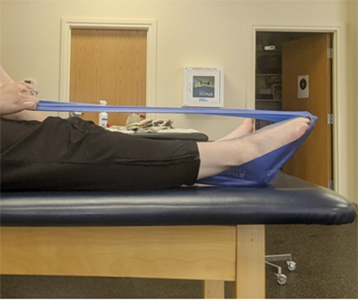
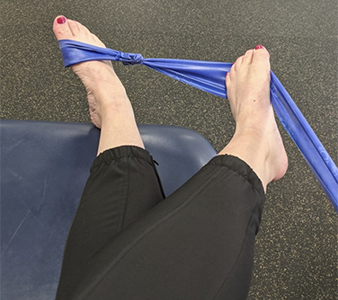
Resisted hip kicks: Place a resistance band around your ankles.
- Holding on to a chair, countertop, or the beam, kick one leg to the front and back. Focus on keeping the body upright and avoid leaning.
- Perform 10 reps.
- Then kick to the side by rotating your leg outward so that your knee points to the ceiling. Lift the leg up to hip level, then return. Perform 10 reps.
- Then kick your leg to the back keeping your hips square, and return. Perform 10 reps.
- Remember to adjust your resistance band length to allow the range you are trying to get to, and it is not too short or too long.
- Perform 2-3 sets of 10 repetitions in each direction and on each leg.
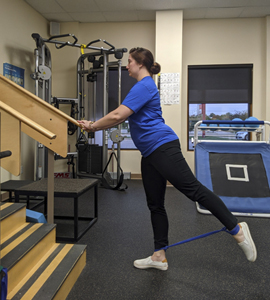
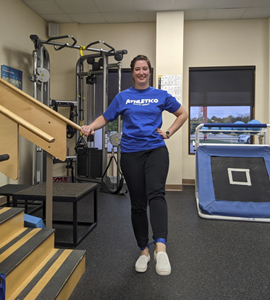
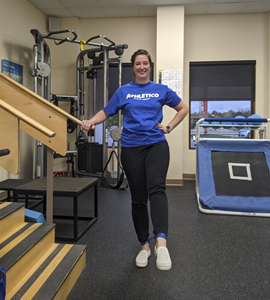
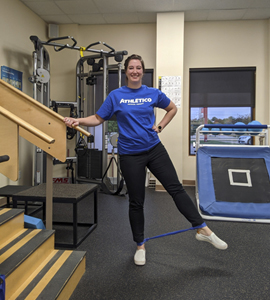
Physical therapy can help establish a good strengthening program for gymnasts to address their symptoms and areas of weakness.
For more information about the benefits of strengthening the foot, click here to refer to our previous barefoot strengthening for gymnast blog.
If pain is not improving, come see us!
If pain is not improving or pain is worsening, it is important that you receive further evaluation by setting up a free assessment at your nearest Athletico. Pushing through pain can potentially lead to damage of the growth plate and subsequently more time out of gymnastics. If you are looking for a more individualized program for a gymnastics injury, you can find an Athletico gymnastics program member near you today.
The Athletico blog is an educational resource written by Athletico employees. Athletico bloggers are licensed professionals who abide by the code of ethics outlined by their respective professional associations. The content published in blog posts represents the opinion of the individual author based on their expertise and experience. The content provided in this blog is for informational purposes only, does not constitute medical advice and should not be relied on for making personal health decisions.
